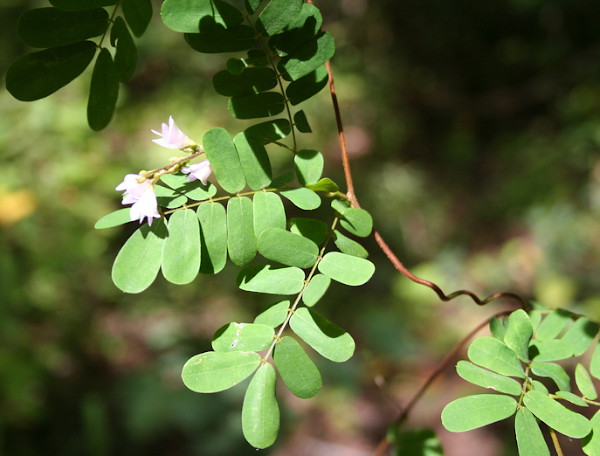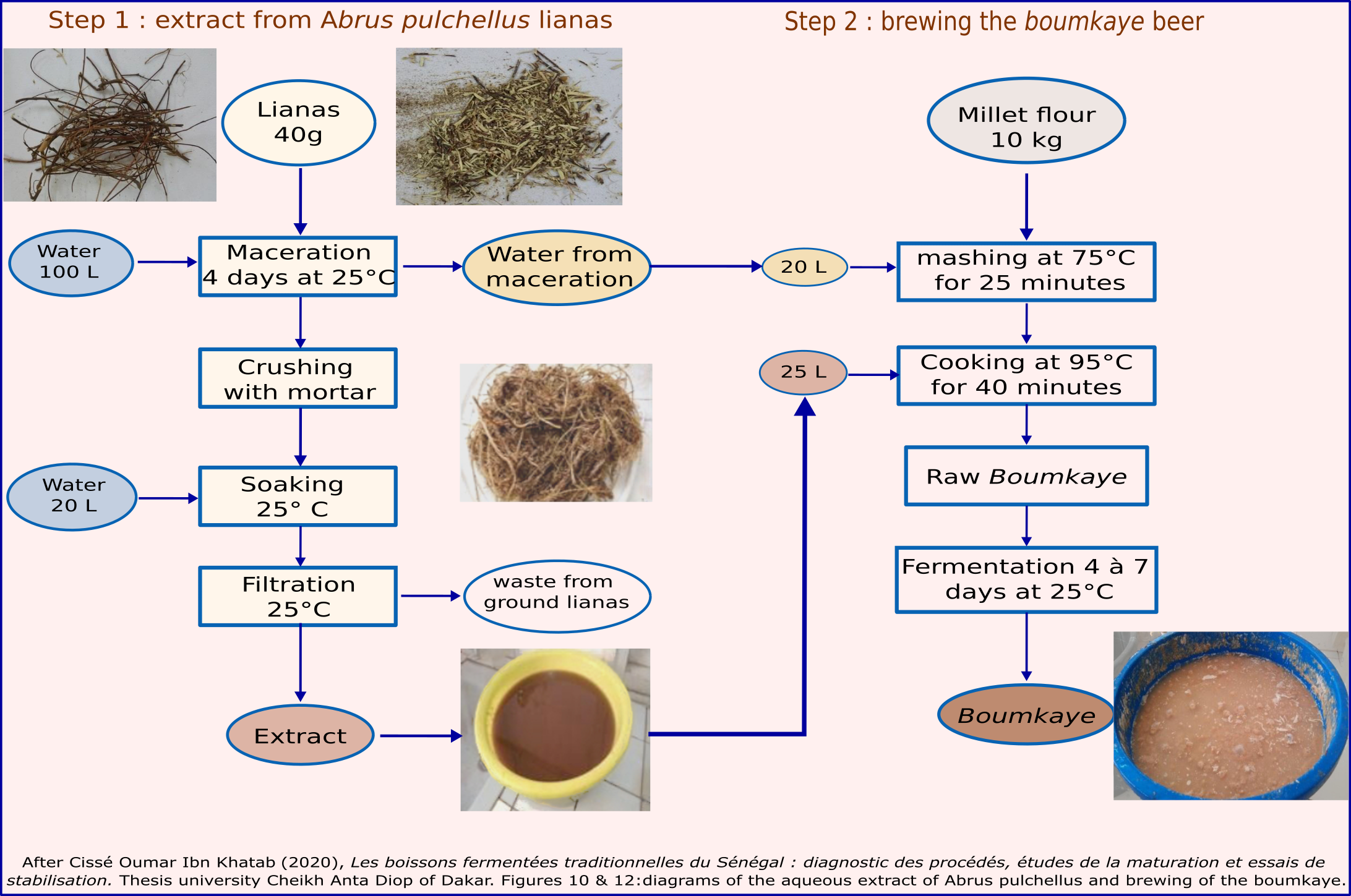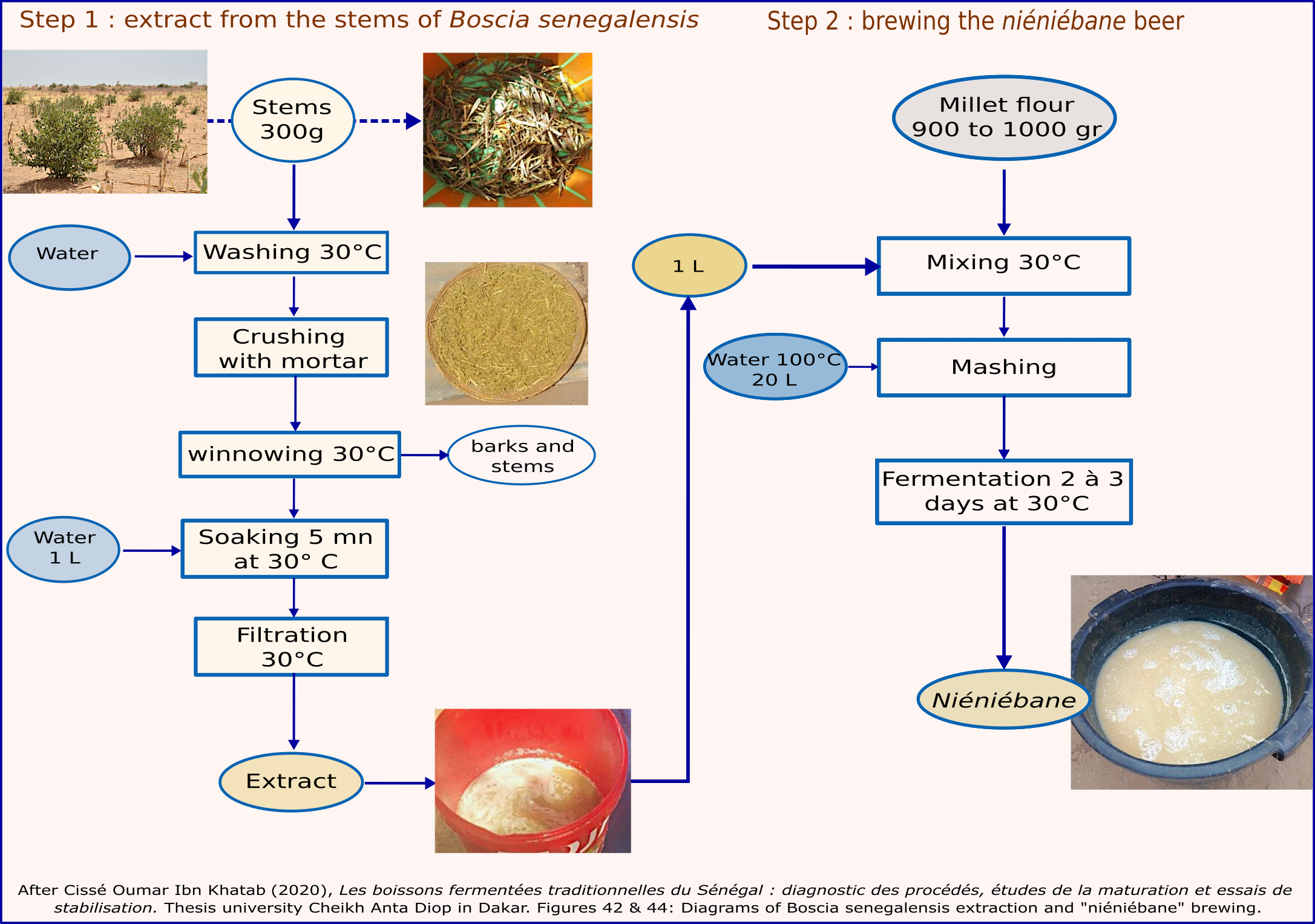Your search results [1 article]
The boumkaye and néniébane beers from Senegal
Boumkaye and Niéniébane are two traditional African beers brewed with millet, the first in the Casamance region of southern Senegal, the second in the Thiès region, inland from Dakar (central Senegal). They were studied by a team of researchers from the Cheikh Anta Diop University in Dakar (Oumar Ibn Khatab Cissé, Guedel Faye, Mahamat Seid Ali, Nicolas Cyrille Ayessou, Mady Cissé, Mariama Diatta and Mama Sakho (2016). Oumar Ibn Khatab Cissé 2020). These researchers made a major discovery: West Africa is home to a method of brewing starch using saccharifying plants, a technique that was previously only documented in East Africa.
Unlike other grain-based African beers, Boumkaye and Niéniébane beers do not require any malting of millet grains. The secret lies in the vines of Abrus pulchellus or the stems and leaves of the shrub Boscia senegalensis. These plants contain enzymes that convert the starch of a cooked millet paste into fermentable sugars. These enzymes are obtained by macerating the vines, stems and leaves for several days. The extract of these plants liquefies the starch in a few dozen minutes at 75°C. Then, a double fermentation, alcoholic and lactic, produces Boumkaye beer or Niéniébane beer, alcoholic beverages, sour and very nourishing.
This method is one of the 6 basic techniques used in the world to brew beer since ancient times. The fact that it has been discovered in Africa is of great significance. A very similar technique exists in south-eastern Democratic Republic of the Congo, Zambia and Tanzania. A Munkoyo beer is brewed with the amylolytic roots of the genus Eminia. This makes Africa the continent that masters all brewing techniques, a kind of ancestral cradle of brewing techniques. This method of brewing is probably more widespread across Africa than the available literature suggests, and probably worldwide.
The Boumkaye reveals another aspect of the social role of beer. The liquid extract of Abrus pulchellus lianas is also recognised and used in Senegal as an anthelmintic, a vermifuge remedy against intestinal parasites. The thick millet soup liquefied by the lianas and not fermented is a medicine. The beer becomes a secondary product when spontaneous fermentation occurs after the millet is cooked and mixed with the liana extract. The leaves and stems of Boscia senegalensis also have anti-parasitic and anti-constipation properties.
Traditional beers in West Africa
Beer has played a major economic and social role in West Africa, and in Africa in general, for centuries. Tracing its African history is possible with the help of oral traditions, documents left by European explorers and Muslim travellers-geographers. The first testimonies of its existence date back to 1068 (Al-Bakri) and 1154 (Al-Idrisi) for the ancient kingdom of Ghana in West Africa (First African Kingdoms).
The brewing and consumption of beer is primarily conditioned by a socio-economic law that allows the conversion of grain stocks into beer, with the consent of the community whose survival depends on its granaries. In times of plenty, beer is an ordinary, healthy and nourishing drink. In times of scarcity, brewing stops or beer is reserved for the older age group.
Beer is also used for rituals and offerings to the ancestral lineages. Its brewing follows strict prescriptions: who and how one brews a beer reserved for the ancestors follows a logic that must preserve the links between them and the living. Historically, the brewing of these special beers has often been a conservatory of ancient African brewing methods: brewing with choice and specific varieties of sorghum rather than with maize which is too recent (17th century) or dedicated to commercial brewing.
Finally, beer is the fermented beverage of festivals and collective ceremonies involving a whole village or community: sowing or harvest festivals, rites of passage of the age groups, weddings, funerals.
This fermented beverage is and has been brewed with local starch sources: various varieties of millet, sorghum, African rice, yams, and since the 16th century with varieties of maize introduced by the Portuguese (or cassava in tropical Africa). African brewing methods have continued to evolve. As in other parts of the world, traditional beer making (as opposed to European-style industrial beers) has adopted new techniques, new sources of starch, new utensils (pottery, then plastic or metal cans and barrels). African brewers use a wide variety of local plants to accelerate the liquefaction of the mash, to clarify the wort before fermentation, or to flavour their beers. Okra (Abelmoschus or Hibiscus esculentus), Curculigo pilosa roots, Adansonia digitata leaves provide amylolytic enzymes. Okra, Cissus quadrangulam, Grewia mollis and cailcedrat barks (Khaya senegalensis) are used to clarify the wort during cooking or decanting in Nigeria and North Cameroon (Seignobos 2002). African brewers also use several techniques to preserve and reuse leavens from one brew to another.
In short, traditional African brewing is a constantly evolving technical world, far removed from the clichés and prejudices that portray it as a fixed and archaic practice doomed to disappear
The different brewing methods in Africa
There are 6 basic methods for saccharifying plant starch, which is an essential technical step for brewing beer. Unlike natural sugars from fruits, berries or sap that are left to ferment to make wine, starch does not ferment spontaneously. It has to be converted into fermentable sugars. This operation characterises beer, inspires its technical definition and marks its difference from other fermented beverages: wines, meads and fermented alcoholic milks (e.g. koumys).
These 6 brewing techniques have been used since the origin of beer 13,000 years ago (Natufians in the Near East) in all regions of the world. All of them operate on a starch that has been previously cooked in water, with the exception of method no 5.
- Insalivation of a cooked starch paste. The ptyalin in human saliva contains a powerful enzyme (α-amylase) that rapidly converts starch into sugars. This method is practised in South America (corn chicha, cassava cachiri from the Guianas) or in Taiwan. It is very old and attested on all continents (Pathway 1: insalivation).
- Germination of cereal grains. The germ produces enzymes to convert the albumen of the grain into sugars and thus nourish the growth of the seed. Humans have turned this biological process to their advantage to make malt. This "invention" of malt is historically linked to the beginnings of cereal farming 10,000 years ago in the Near East and then in the Huang-He basin in China (Pathway 2: germination).
- The cultivation of amylolytic fungi on a cooked starch carrier. These microscopic fungi are able to convert starch into simple sugars. They are the source of the beer starter well known in Asian brewing traditions. This brewing technique is also known in Africa (Songola from Democratic Republic of the Congo) and South America (Pathway 3: fungi).
- Amylolytic plants. Some plant organs (roots, lianas) store enzymes that convert starch into sugars, as do grain germs. An aqueous extract of these shelled plants is used to liquefy and convert a thick starch slurry into fermentable sugars, a preparatory stage for alcoholic fermentation. This brewing method is documented in Africa: south-eastern Democratic Republic of the Congo (munkoyo beer) and Senegal (boumkaye beer, the subject of this article). It probably exists on other continents, although it has remained unnoticed by ethnologists or historians (Pathway 4: plants).
- The over-ripening of starchy fruits (plantain, carob pod fruit, Pandanus julianettii seeds in Papua New Guinea, etc.), sago pith (Metroxylon) in Papua-New Guinea and Borneo). Starch saccharification is endogenous as the plant provides its own amylases. It is sufficient to let starchy fruits such as plantain ripen to obtain fermentable sugars and a banana beer (Uganda, Rwanda, Burundi, North Tanzania). Wild yeasts and lactic acid bacteria ensure the fermentations (Pathway 5: overripening).
- The conversion of starch in an acidic medium. The acidity of the liquid medium alone is sufficient to saccharify a starch starch without enzymatic action. This purely chemical method operates in the presence of lactic acid, for example. As old as insalivation, this brewing technique is used to make sour beers from Central Europe or Russia such as kwas or braga. This method is also complementary to enzymatic methods for brewing sour beers when lactic acid fermentation occurs with the alcoholic fermentation (Pathway 6: acidic hydrolysis).
The African continent knows and masters all these brewing methods. This is an important point to note. Unfortunately, we do not know how to trace the long history of each of these brewing methods, even if we rightly assume their antiquity in Sahelian and tropical Africa. The study of written documents and oral traditions is no longer sufficient to deal with the older periods. The archaeology of brewing is still in its infancy in Africa.
Boumkaye beer from Senegal
The Boumkaye beer is a traditional millet beer (Pennisetum glaucum) of the Diolas (Joolas), an ethnic group from Casamance in southern Senegal. It is used as a drink, food and medicine.
The brewing technique of boumkaye is related to method no 4 (amylolytic plants). The decoction of the stems of Abrus pulchellus (or Abrus melanospermus), a thin-stemmed climbing vine, is used to liquefy and convert millet porridge into sugars. The entire brewing process is therefore divided into two phases: 1) preparation of the lianas decoction 2) addition of this decoction to a millet porridge, cooking and fermentation.
The decoction of Abrus pulchellus
The lianas macerate in water at room temperature for 3 to 4 days. Once softened, they are crushed with a mortar to extract their active components (enzymes, tannins). The extract is then filtered. The result is a liana maceration water and a liana extract.
Millet saccharification and double fermentation.
The millet porridge consists of 10 kg of millet flour for 20 l of water from the maceration of Abrus pulchellus vines. It is cooked twice in succession. The first lasts about 25 to 30 minutes and brings the paste to a maximum temperature of 75°C.
The second heating starts with the addition of 25 litres of Abrus pulchellus liana extract. The cooking lasts 40 minutes at 95°C. After cooling, the "raw Boumkaye" is ready to be consumed.
This "raw Boumkaye" is kept at room temperature to undergo a double fermentation (alcoholic and lactic) for 4 to 7 days, without added leaven or yeast, to produce the Boumkaye beer itself. This sour beer contains about 4.5 % alcohol by volume.
Niéniébane beer from Senegal
Niéniébane beer is a traditional millet beer of the Seerer, an ethnic group living in the hinterland of Dakar in central Senegal. The diagram shown is that of the Seerer Diobass of the Thiès region.
The technique is similar to the brewing of boumkaye beer, hence also related to method n° 4 (amylolytic plants). The decoction of the stems of Boscia senegalensis makes it possible to liquefy and convert into sugars a millet slurry following 2 phases: 1) preparation of a decoction from Boscia senegalensis 2) mixing this decoction with a millet slurry, cooking and fermentation.
The decoction of Boscia senegalensis
Boscia senegalensis (Capparaceae) ) is an evergreen shrub native to West Africa. Crushing the stems of Boscia senegalensis in a mortar removes the bark. The crushed stems are softened in water and then crushed again in a wooden mortar. An aqueous extract of the Boscia senegalensis stems is obtained after filtration.
Saccharification of millet and its fermentation.
The millet flour is mixed with the aqueous extract from the stems of Boscia senegalensis in equal volume. 20 l of hot water is added to mash the mixture. A fermentation of 2 to 3 days at 30°C yields the Niéniébane beer. This slightly alcoholic sour beer contains about 1 to 1.25% alcohol by volume.
The specific features of Boumkaye and Niéniébane beers
The first distinctive characteristic is their brewing method. The use of an amylolytic plant decoction links it to Pathway 4 (see above), which is one of the least known and documented methods in the general history of beer in the world. Having specimens of traditional beers of this type is an opportunity for both scientific research and the history of African brewing.
The second specificity is the double alcoholic and lactic fermentation. This is often the case for traditional African beers. Analysis of these beers shows that the high-tannin plant decoctions offer protection against the proliferation of undesirable microorganisms, to which is added an acidic pH (≈3.5) after 7 days of fermentation. Fermented beverages and traditional African foods offer a relatively good microbiological quality (provided they are consumed quickly) and an undeniable nutritional wealth.
The third specificity is their close link with the traditional medicines of Senegal. In its liquid and fermented form, boumkaye is consumed like a beer. It can also be ingested as an antibacterial and antiparasitic remedy before fermentation when it is still a porridge. One may wonder whether the persistence of this brewing technique and the trade in this remedy-beer are not the result of this dual nature of the Boumkaye. The resiliency of this beer and other Joola fermented beverages (palm wine, mead) undoubtedly owes much to the historical resistance of the Joola to the forced Islamisations of past centuries and to European colonial policies.
Conclusions (provisional)
There are other plants with amylolytic properties used for brewing beer in Africa.
This is the case of the roots of Curculigo pilosa (Hypoxidaceae), an herbaceous plant, used to saccharify unmalted sorghum and make beer in Burkina Faso, or to sweeten millet porridges for children (Dicko et al. 1999). These authors have analysed the activity of-β-amylase present in the rhizomes and proposed this solution to compensate for the low enzymatic power of sorghum, which has become a raw material for industrial brewers in Nigeria since the import of barley malt was banned. Ironically, traditional African brewing methods have come back to the rescue of the brewing industry, which had sworn their demise in Africa.
Bulbs of Gladiolus klattianus Hutch. (Iridaceae) are used in southern Burkina Faso to brew beer using the same brewing method. These bulbs contain a duo of enzymes ensuring complete saccharification of starch: α- and β-amylases (Dicko 1999, 99).
The same study (Dicko 1999, 99) confirmed the presence in Boscia senegalensis leaves of a complex of active enzymes ensuring the degradation of cell walls and the complete saccharification of starch: endo- and exo-glucanases, α- and β-amylases. The leaves of Gladiolus klattianus used to brew traditional beers are therefore very effective.
The brewing of Boumkaye and Niéniébane beers can be optimised to improve the stability of these two fermented beverages and prevent their contamination by pathogens (Cissé O. I. K. & al. 2018). These optimised processes (shortened cooking times, autoclave sterilisation) are aimed at semi-industrial production in Senegal.
Bibliography
Oumar Ibn Khatab Cissé, Guedel Faye, Mahamat Seid Ali, Nicolas Cyrille Ayessou, Mady Cissé, Mariama Diatta et Mama Sakho (2016), Diagnostic du procédé et caractérisation physico-chimique et biochimique d’une boisson fermentée à base de mil : le Boumkaye. Afrique SCIENCE 12(5) (2016) 59 – 65. researchgate.net/publication/310467621_Diagnostic_du_procede_et_caracterisation_physico-chimique_et_biochimique_d%27une_boisson_fermentee_a_base_de_mil_le_Boumkaye
Cissé O. I. K., Ayessou. N. C., Faye P. G., Cisse M., Camara. A. C., Bodian A., Ndiaye C., Sakho M. & Diop C. M. (2018). Process Diagnosis and Aging Effects on a Traditional Millet-Based Drink: Boumkaye. Food and Nutrition Sciences, 09 (05): 464-473. researchgate.net/publication/325172158_Process_Diagnosis_and_Aging_Effects_on_a_Traditional_Millet-Based_Drink_Boumkaye
Cissé O. I. K., Ayessou N. C., Ndiaye B, Cissé M., Sakho M. and Diop C. M. (2018). Stabilization of Boumkaye’s drink for an accessibility in the markets. European Scientific Journal, 14 (34), 82-91. researchgate.net/publication/330504636_Stabilization_of_Boumkaye's_Drink_for_an_Accessibility_in_the_Markets
Cissé Oumar Ibn Khatab (2020), Les boissons fermentées traditionnelles du Sénégal : diagnostic des procédés, études de la maturation et essais de stabilisation. Thèse soutenue à l’université Cheikh Anta Diop de Dakar. Download
Dicko Mamoudou Hama (1999), Purification et Propriétés Physico-chimiques des enzymes de Curculigo pilosa, Gladiolus klattianus et Boscia senegalensis catalysant l'hydrolyse des polysaccharides (amidon et B-glucanes). Thèse soutenue à l’université de Ouagadougou. www.beep.ird.fr/collect/uouaga/index/assoc/M07603.dir/M07603.pdf
Dicko MH, Searle-Van Leeuwen MJF, Hilhorst R, Ouedraogo OG, Beldman G, Traore AS (1999). Purification and characterization of β amylase from Curculigo pilosa. Appl. Microbiol. Biotechnol. 5: 802-805. researchgate.net/publication/226555731_Purification_and_characterization_of_b-amylase_from_Curculigo_pilosa
Ouôba, P., A. M. Lykke, J. Boussim & S. Guinko (2006), La flore médicinale de la Forêt Classée de Niangoloko (Burkina Faso). Etudes flor. vég. Burkina Faso 10, 5-16. ethnopharmacologia.org/prelude2020/pdf/biblio-ho-27-ouoba.pdf
Seignobos Christian (2002), Trente ans de bière de mil à Maroua, in Ressources vivrières et choix alimentaires dans le bassin du lac Tchad, Christine Raimond, Éric Garine et Olivier Langlois (dir.) books.openedition.org/irdeditions/1680






 Lam in Senegal, Louba.jpg)
